How to Propagate Succulents Without Being Disappointed
Author: Jen Worst | Editor: Omar Alonso
Review & Research: Jen Worst & Chris Miller

The succulent community will give you countless tips about how to propagate succulents but here’s the big secret about propagating succulents: most methods will work just fine!
For the most part, propagating succulents is very easy to do. There are all sorts of ways that you can complicate things in order to increase your success rates or just to streamline the process, but succulents reproduce through propagation naturally all the time.
You can drop a leaf in the corner of a room and check back in a month or two and you’ll most likely see growth. People that go "proplifting" and find tons of leaves on the floor of a store can attest to just how easy it can be to propagate these plants.
How to Propagate Succulents: The 3 Most Popular Ways
- Cuttings
- Plucking off individual leaves
- Pups/Offsets
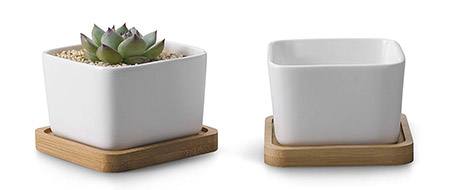
Common Succulent Variables to Consider
Here are the common variables that people like to adjust for. Everyone has their own tricks of the trade for adjusting these variables, and we’ll cover as many of them as we can to give you inspiration for your own little succulent farm.
Misting: Some people like to mist their succulents while they’re sitting in their propagation medium, whereas others like to add a few drops of water near the roots. Usually, the cutting/leaf itself will be what provides water and food to the new growth, and excess water can actually cause your succulent leaves to rot, so this can go either way.
Usually, a quick mist every day or two is a good idea, but whether or not it actually helps can be debatable. Once the leaf is getting drier, you’ll definitely want to add some extra water, and as long as you aren’t soaking the leaves with mist, you should be just fine.
Sunlight: Here’s another variable that really depends on where you live and what type of succulents you’re trying to prop. Usually, indirect and filtered sunlight for part of the day is good, but you can use lamps too if you don’t have a good window for light. Too much sunlight will damage the leaves, but too much darkness can slow progress.
Soil: Choosing your medium is also important. Generally, with succulents, you want something that drains well and isn’t too dense. Having said that, I’ve had props fall onto the cold, dark cement floor in a corner, and I’ve found them months later with growth and roots.
Humidity: The level of humidity in the air can also have an impact on your success rates, but as long as it’s not bone dry or soaking wet, this shouldn’t be a deal-breaker. Humidity matters more with other types of houseplants, or plants that are already established.
Time: How long does succulent propagation take? At the risk of sounding like a broken record, once again it depends on a lot of factors, including the above variables.
Even in the same tray, the same leaves from the same parent-plant will grow at different rates. There’s no set time, but anyone who has ever propped will be able to tell you that it takes a lot of patience.
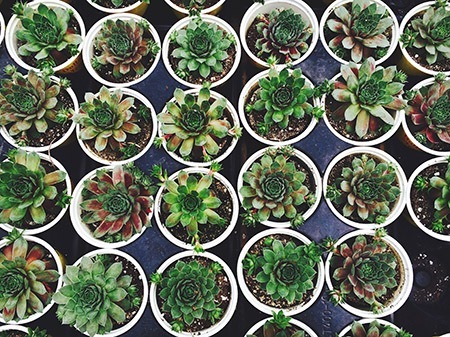
The answer to how long it takes to propagate a succulent is “until you start to forget about it, at which point it happens very quickly.”
Soil vs Water Propagation
Water propagation is a preferred method for plenty of different house plants, outdoor plants, and even some succulents.
I’ve seen people use a water bottle propagation method for all types of different succulents and they always report really high success rates, so it’s definitely worth checking out. They make a bunch of holes or slits in a water bottle, and they stick succulents into the holes so that they’re poking out.
Sometimes, the leaves will be submerged in the water, other times they’ll just soak up moisture from the air from being in a moist, somewhat-enclosed area.
With the soil method, you’re simply laying down some combination of soil, peat, either perlite or vermiculite, and some sort of food for the plants (do some research to pick the right fertilizer numbers). Start by spreading it out in a bowl, a dish, a pie plate, a leftover container from a frozen dinner, or just about anything else.
As long as the mother leaf (the one that the propagation is growing out from) still has any plumpness left in it, then you don’t really need to water your succulent since the pup is still getting its water from the mother. Once the mother leaf has completely dried out, you can pluck it away.
How to Grow Succulents From Cuttings
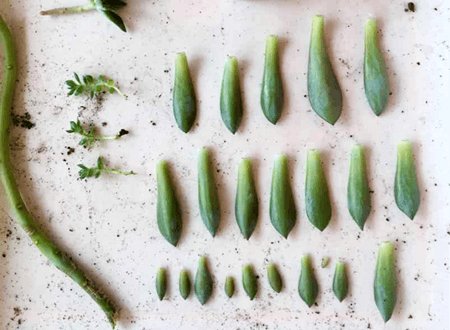
Succulent cuttings are the easiest way to turn one succulent plant into multiple. In some cases, you can just break off the leaf, but in other cases you’ll have an easier time if you take a larger cutting. It really depends on the succulent.
For example, Jade is a plant that has leaves and branches. When you remove a leaf, two more will sprout in its place, usually accompanied by two new shoots of branches as well.
This allows you to strategically prune your Jade to make it grow in fuller and to create interesting shapes for your plant to fill in. You can do it with all types of jade plants, too.
If you want to propagate your Jade succulent, you can remove a single leaf and it may produce roots and new growth, but if you’re able to wait until there’s a larger branch to remove, you’ll be months and months (or even years) further ahead in the process, since the cutting will root relatively quickly and will already have plenty of branches and leaves already.
You’ll already have an established plant. Of course, you still have to wait for that growth to occur in the first place, but if you purchase an established plant you can usually turn it into several plants.
This rings true with many other types of succulents, too. Some varieties will have their best chance at propagating from their leaves and don’t really have branches or larger parts of the plant to cut, whereas others will work best when you take off a bigger chunk.
If you’re doing this for fun (and you should be!), your best bet is to experiment a bit. Try both methods. Set up a couple different propagation stations where you can experiment with different methods, light, water/mist techniques, and so on. See what works best for your climate, environment, patience levels, access to light, and so on.
Various Types of Succulents Will Propagate Differently
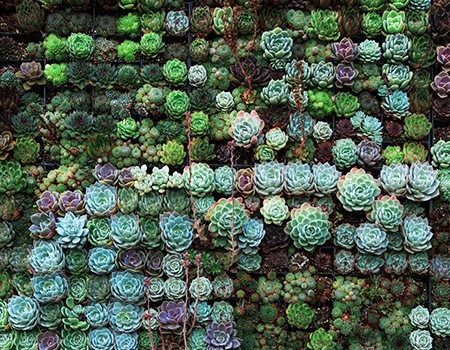
Specific succulent types will propagate differently from the “normal” way. You'll want to research your specific breed (I can't possibly list them all), but I'll talk about a few of the most popular and common.
Echeveria: This popular family of succulents is usually pretty easy to propagate. You simply pluck off some of the leaves and follow any standard procedure. One small plant has a ton of leaves.
After you’ve plucked off some leaves, a little pup may start growing in their place. If your echeveria isn’t getting enough sun, it’ll start to get very leggy and tall, ultimately toppling over. When this happens, people like to cut off the top and root it into a new plant.
Jade: We’ve discussed Jade already because this wildly popular and gorgeous succulent is very easy to propagate. You can cut a stem and root it, or pluck off a leaf to start a brand new plant from scratch.
Burro’s Tail: To propagate Burro’s tail and similar Sedums, just choose any stem/off-shoot and snap it off where it connects to the main plant. Pluck off a few rows of leaves from the bottom (where it was previously connected to the rest of the plant), and allow it a couple of days to callous over at the end.
Next, stick that calloused end into soil and leave it alone. Water it lightly as you would any succulent, and soon roots still start to shoot out from the parts of the stem that are buried in the soil.
How to Plant Succulent Cuttings Once They’ve Rooted
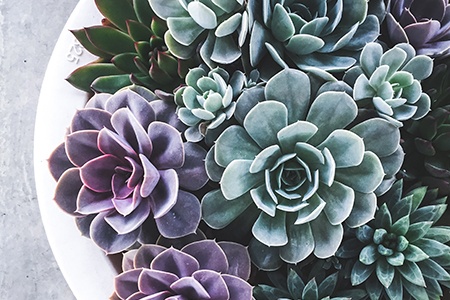
Once your props have grown little pups and have somewhat established roots, you can move them into a small planter. If you started them off in a tray of soil, gently lift them up.
You could use a spoon to scoop them up along with some of the surrounding girt in order to reduce the disturbance to the roots. If you just pick up the pup and roots itself, that’s okay too.
Once the original leaf has dried up, that’s usually a good time to move your new succulent into its own container and to start a more regular watering routine for succulents.
When to Upgrade to a Larger Pot
When you first moved your little pups or rooted props from their tray, egg carton, or wherever you started them into a smaller container, you knew it was only a matter of time until you would need to move then again.
You want to take care to disturb the roots as seldom as possible, so pulling up your little transplant to see how it’s rooting is counter-productive and will hurt the plant. Rooting succulents need time to establish themselves to ward off bacteria, fungi and fungus gnats, spider mites, and grow strong up top and below the soil.
Having said that, if your plant seems like it's starting to outgrow the small 1-inch or so planter you moved it into, and you’re able to lift up the entirely of the soil around the plant with a little tug, then it’s probably time to move it into something larger.
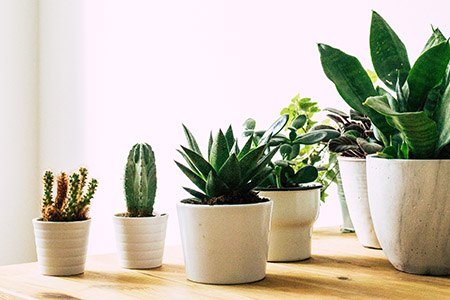
Certain types of plants actually want to be root-bound to a certain degree, so check the unique plant care tips for your plant before doing anything too drastic. Generally speaking, once you can lift up all of the soil by slowly lifting up your plant, it would benefit from a larger planter to continue its growth.
Final Thoughts on Propagating Succulents
Learning how to propagate succulents isn’t rocket science, but it’s definitely science. There’s also some art in there, too. Will arranging your leaves into beautiful mandala patterns help them to grow roots and pups?
No, but it’s still a fun way to express your creativity with art that will grow and thrive over time. It’s very rewarding, you’ll find yourself running over to check on your leaves everyday and finally they’ll start to root and all of that effort will pay off! But remember, succulent care sometimes means leaving them alone and letting them do their thing.
Remember that not every leaf is going to grow roots. Some will grow a pup with no roots, and vice-versa, and some will just rot and turn black and not grow anything. It’s all part of the process, nobody has a 100% success rate.



